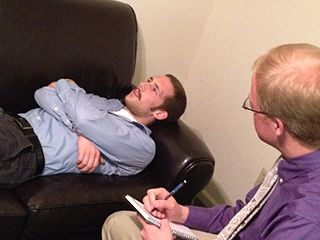
Anxiety is an emotion which is characterised by an unpleasant state of inner turmoil and includes feelings of dread over anticipated events. Anxiety is different from fear in that fear is defined as the emotional response to a present threat, whereas anxiety is the anticipation of a future one. It is often accompanied by nervous behavior such as pacing back and forth, somatic complaints, and rumination.
Paranoia is an instinct or thought process that is believed to be heavily influenced by anxiety, suspicion, or fear, often to the point of delusion and irrationality. Paranoid thinking typically includes persecutory beliefs, or beliefs of conspiracy concerning a perceived threat towards oneself. Paranoia is distinct from phobias, which also involve irrational fear, but usually no blame.

In conventional usage, boredom, ennui, or tedium is an emotion characterized by uninterest in one's surrounding, often caused by a lack of distractions or occupations. Although, "There is no universally accepted definition of boredom. But whatever it is, researchers argue, it is not simply another name for depression or apathy. It seems to be a specific mental state that people find unpleasant—a lack of stimulation that leaves them craving relief, with a host of behavioral, medical and social consequences." According to BBC News, boredom "...can be a dangerous and disruptive state of mind that damages your health"; yet research "...suggest[s] that without boredom we couldn't achieve our creative feats."
Dissociation is a concept that has been developed over time and which concerns a wide array of experiences, ranging from a mild emotional detachment from the immediate surroundings, to a more severe disconnection from physical and emotional experiences. The major characteristic of all dissociative phenomena involves a detachment from reality, rather than a false perception of reality as in psychosis.
Psychological trauma is an emotional response caused by severe distressing events that are outside the normal range of human experiences. It must be understood by the affected person as directly threatening the affected person or their loved ones with death, severe bodily injury, or sexual violence; indirect exposure, such as from watching television news, may be extremely distressing and can produce an involuntary and possibly overwhelming physiological stress response, but does not produce trauma per se. Examples include violence, rape, or a terrorist attack.
The Hearing Voices Movement (HVM) is the name used by organizations and individuals advocating the "hearing voices approach", an alternative way of understanding the experience of those people who "hear voices". In the medical professional literature, ‘voices’ are most often referred to as auditory verbal hallucinations. The movement uses the term ‘hearing voices’, which it feels is a more accurate and 'user-friendly' term.
Hearing Voices Networks, closely related to the Hearing Voices Movement, are peer-focused national organizations for people who hear voices and supporting family members, activists and mental health practitioners. Members may or may not have a psychiatric diagnosis. Networks promote an alternative approach, where voices are not necessarily seen as signs of mental illness and regard hearing voices as a meaningful and understandable, although unusual, human variation. Voices are not seen as the problem, rather it is the relationship the person has with their voices that is regarded as the main issue.
Acute stress reaction and acute stress disorder (ASD) is a psychological response to a terrifying, traumatic or surprising experience. Combat stress reaction (CSR) is a similar response to the trauma of war. The reactions may include but are not limited to intrusive or dissociative symptoms, and reactivity symptoms such as avoidance or arousal. It may be exhibited for days or weeks after the traumatic event. If the condition is not correctly addressed, it may develop into post-traumatic stress disorder (PTSD).

Prairie madness or prairie fever was an affliction that affected settlers in the Great Plains during the migration to, and settlement of, the Canadian Prairies and the Western United States in the nineteenth century. Settlers moving from urbanized or relatively settled areas in the East faced the risk of mental breakdown caused by the harsh living conditions and the extreme levels of isolation on the prairie. Symptoms of prairie madness included depression, withdrawal, changes in character and habit, and violence. Prairie madness sometimes resulted in the afflicted person moving back East or, in extreme cases, suicide.

In psychology, emotional detachment, also known as emotional blunting, is a condition or state in which a person lacks emotional connectivity to others, whether due to an unwanted circumstance or as a positive means to cope with anxiety. Such a coping strategy, also known as emotion-focused coping, is used when avoiding certain situations that might trigger anxiety. It refers to the evasion of emotional connections. Emotional detachment may be a temporary reaction to a stressful situation, or a chronic condition such as depersonalization-derealization disorder. It may also be caused by certain antidepressants. Emotional blunting, also known as reduced affect display, is one of the negative symptoms of schizophrenia.
A major depressive episode (MDE) is a period characterized by symptoms of major depressive disorder. Those affected primarily exhibit a depressive mood for at least two weeks or more, and a loss of interest or pleasure in everyday activities. Other symptoms can include feelings of emptiness, hopelessness, anxiety, worthlessness, guilt, irritability, changes in appetite, difficulties in concentration, difficulties remembering details, making decisions, and thoughts of suicide. Insomnia or hypersomnia and aches, pains, or digestive problems that are resistant to treatment may also be present.
Psycho-oncology is an interdisciplinary field at the intersection of physical, psychological, social, and behavioral aspects of the cancer experience for both patients and caregivers. Also known as psychiatric oncology or psychosocial oncology, researchers and practitioners in the field are concerned with aspects of individuals' experience with cancer beyond medical treatment, and across the cancer trajectory, including at diagnosis, during treatment, transitioning to and throughout survivorship, and approaching the end-of-life. Founded by Jimmie Holland in 1977 via the incorporation of a psychiatric service within the Memorial Sloan Kettering Cancer Center in New York, the field has expanded drastically since and is now universally recognized as an integral component of quality cancer care. Cancer centers in major academic medical centers across the country now uniformly incorporate a psycho-oncology service into their clinical care, and provide infrastructure to support research efforts to advance knowledge in the field.

In applied psychology, interventions are actions performed to bring about change in people. A wide range of intervention strategies exist and they are directed towards various types of issues. Most generally, it means any activities used to modify behavior, emotional state, or feelings. Psychological interventions have many different applications and the most common use is for the treatment of mental disorders, most commonly using psychotherapy. The ultimate goal behind these interventions is not only to alleviate symptoms but also to target the root cause of mental disorders.

Reminiscence therapy is used to counsel and support older people, and is an intervention technique with brain-injured patients and those who appear to have "Alzheimer's and other forms of cognitive disease."
Derealization is an alteration in the perception of the external world, causing those with the condition to perceive it as unreal, distant, distorted or in other words falsified. Other symptoms include feeling as if one's environment is lacking in spontaneity, emotional coloring, and depth. It is a dissociative symptom that may appear in moments of severe stress.
Folie à deux, also known as shared psychosis or shared delusional disorder (SDD), is a rare psychiatric syndrome in which symptoms of a delusional belief, are "transmitted" from one individual to another.

A persecutory delusion is a type of delusional condition in which the affected person believes that harm is going to occur to oneself by a persecutor, despite a clear lack of evidence. The person may believe that they are being targeted by an individual or a group of people. Persecution delusions are very diverse in terms of content and vary from the possible, although improbable, to the completely bizarre. The delusion can be found in various disorders, being more usual in psychotic disorders.
Psychological hardiness, alternatively referred to as personality hardiness or cognitive hardiness in the literature, is a personality style first introduced by Suzanne C. Kobasa in 1979. Kobasa described a pattern of personality characteristics that distinguished managers and executives who remained healthy under life stress, as compared to those who developed health problems. In the following years, the concept of hardiness was further elaborated in a book and a series of research reports by Salvatore Maddi, Kobasa and their graduate students at the University of Chicago.

Cotard's syndrome, also known as Cotard's delusion or walking corpse syndrome, is a rare mental disorder in which the affected person holds the delusional belief that they are dead, do not exist, are putrefying, or have lost their blood or internal organs. Statistical analysis of a hundred-patient cohort indicated that denial of self-existence is present in 45% of the cases of Cotard's syndrome; the other 55% of the patients presented with delusions of immortality.

The COVID-19 pandemic has impacted the mental health of people across the globe. The pandemic has caused widespread anxiety, depression, and post-traumatic stress disorder symptoms. According to the UN health agency WHO, in the first year of the COVID-19 pandemic, prevalence of common mental health conditions, such as depression and anxiety, went up by more than 25 percent. The pandemic has damaged social relationships, trust in institutions and in other people, has caused changes in work and income, and has imposed a substantial burden of anxiety and worry on the population. Women and young people face the greatest risk of depression and anxiety. According to The Centers for Disease Control and Prevention study of Mental Health, Substance Use, and Suicidal Ideation During the COVID-19 Pandemic, "63 percent of young people reported experiencing substantial symptoms of anxiety and depression".









